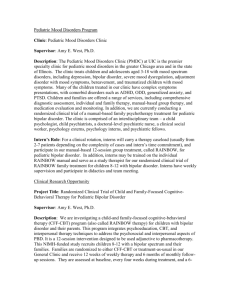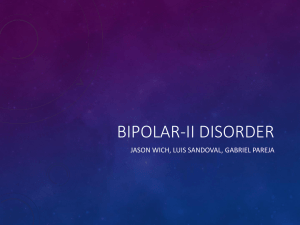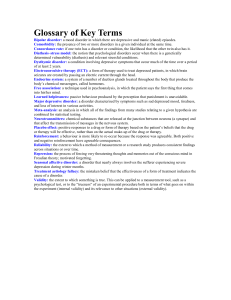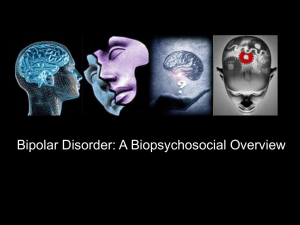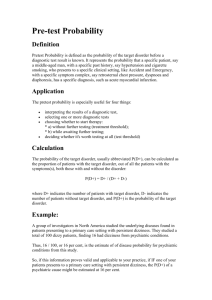File
advertisement
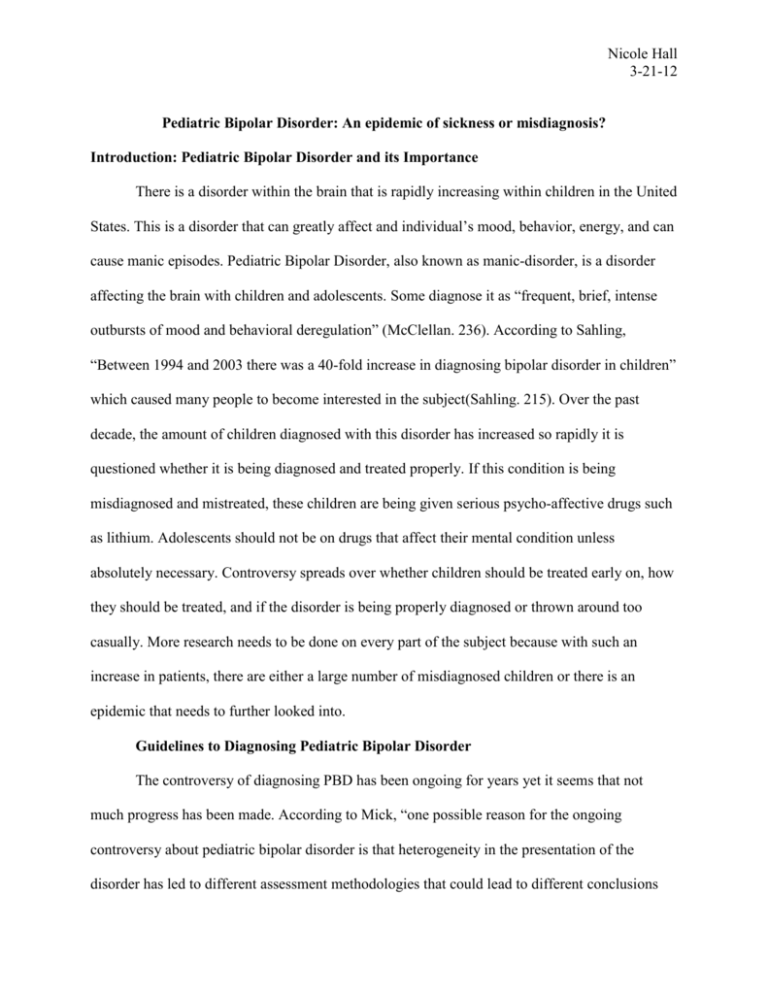
Nicole Hall 3-21-12 Pediatric Bipolar Disorder: An epidemic of sickness or misdiagnosis? Introduction: Pediatric Bipolar Disorder and its Importance There is a disorder within the brain that is rapidly increasing within children in the United States. This is a disorder that can greatly affect and individual’s mood, behavior, energy, and can cause manic episodes. Pediatric Bipolar Disorder, also known as manic-disorder, is a disorder affecting the brain with children and adolescents. Some diagnose it as “frequent, brief, intense outbursts of mood and behavioral deregulation” (McClellan. 236). According to Sahling, “Between 1994 and 2003 there was a 40-fold increase in diagnosing bipolar disorder in children” which caused many people to become interested in the subject(Sahling. 215). Over the past decade, the amount of children diagnosed with this disorder has increased so rapidly it is questioned whether it is being diagnosed and treated properly. If this condition is being misdiagnosed and mistreated, these children are being given serious psycho-affective drugs such as lithium. Adolescents should not be on drugs that affect their mental condition unless absolutely necessary. Controversy spreads over whether children should be treated early on, how they should be treated, and if the disorder is being properly diagnosed or thrown around too casually. More research needs to be done on every part of the subject because with such an increase in patients, there are either a large number of misdiagnosed children or there is an epidemic that needs to further looked into. Guidelines to Diagnosing Pediatric Bipolar Disorder The controversy of diagnosing PBD has been ongoing for years yet it seems that not much progress has been made. According to Mick, “one possible reason for the ongoing controversy about pediatric bipolar disorder is that heterogeneity in the presentation of the disorder has led to different assessment methodologies that could lead to different conclusions Nicole Hall 3-21-12 and descriptions of children with bipolar like symptoms that are independent of the underlying psychopathology being assessed” (Mick et all. 1). Many different approaches are taken to diagnose PBD and there are not very strict or intricate guidelines on the subject. There are not structured diagnostic guidelines available on the subject so some physicians have turned to using the Child Behavior Check List (CBCL) (Society of Biological Psychiatry, 931). This method was not specifically made for PBD but it showed a “consistent pattern of impairments in syndrome congruent CBCL scales suggesting that it may be a useful diagnostic” while there are no other ones to go by (Society of Biological Psychiatry, 932). The CBCL may be adequate for diagnosing but it seems as if something could be made specifically for the disorder that was more precise. The checklist will never be as good as a concrete diagnostic guideline made specifically for the disorder. Staton believes that “recurrent, or chronic, simultaneous presence of any two of the symptoms elation, grandiosity, and racing thoughts and a total of five DSM-IV manic symptoms (without specific cardinal symptom, duration, or episodicity requirements)” will make it obvious which patients have BD and which ones have other disorders. (Staton, Volness, Beatty. 205). If Staton is right, then there does not need to be anything further done on the guidelines of diagnosing pediatric bipolar disorder: but if he is correct then the sudden, and drastic, increase in children with PBD does not make sense. The rapid increase in diagnosis of bipolar disorder in children has even caught the attention of other countries. Holtman, Bolte, and Poustka argue that America’s standards in diagnosing BD are much different than those of other countries. Their studies show that three out of four children previously diagnosed with BD in the United States were diagnosed with other, less extreme, disorders in Europe. (Holtman et al 1). This suggests that the United States is either diagnosing BD too loosely or Europe is not properly diagnosing their patients. Either way is Nicole Hall 3-21-12 harmful to children and the medical population. Miss-diagnosing will cause the child to get inappropriate, and possibly harmful treatment, and will also cause the medical population to look a lot less credible because of the mere amount of diagnoses that were not properly handled in either case. Another aspect that makes it increasingly difficult to make guidelines to diagnose pediatric bipolar disorder is the debate on whether it is the same disorder as adult bipolar disorder. There is an ongoing debate on whether they should be tackled as the same illnesses or if they should be considered completely opposite. The rates PBD diagnoses cause this debate to become complicated. McClellan argues that “if the rates are the same, either the age at onset has shifted markedly downward (or accurate identification is now possible at a much younger age), adult prevalence rates are grossly underestimated, and/or the overall prevalence of the disorder is increasing at a remarkable rate” (McClellan, 236). If these rates are accurate and the adult rates are also precise then the only other possibility it seems is that Pediatric Bipolar Disorder and adult-onset Bipolar Disorder are not the same illness (McClellan, 236). It is impossible to come up with proper guidelines if there cannot even be a consensus made on what the disorder is. There needs to be more research done on what Pediatric Bipolar Disorder actually is instead of physicians just assuming it is the same as adult onset Bipolar Disorder. Many studies have shown differences between adult and child onset BD which compliments McClellan’s statement that there is a large likelihood that childhood and adult BD cannot be the same illness. Maniscalco and Hamrin observed that adult patients showed periods of mania with depression and well periods while children had longer episodes of constant conduct problems with mania mixed in (Maniscalco, Hamrin. 344). Children and adults are showing different symptoms that are most definitely mood related and manic, but that are not the Nicole Hall 3-21-12 same in the way they are shown. The symptoms are being shown differently so it only makes sense that the possibility of two different disorders be taken into account. The Treatment of Child Onset Bipolar Disorder There is a large debate on the appropriate treatment of patients with childhood onset bipolar disorder. A lot of this debate seems to stem from the issue discussed previously of almost nonexistent diagnostic guidelines. According to Littrell and Lyons, “Rather than looking for treatments perhaps more appropriate for younger children, drugs with proven efficacy in treating Bipolar Disorder in adults (lithium, atypical antipsychotics, anticonvulsants) were extended to the treatment children with Bipolar Disorder diagnoses” and this created a large amount of controversy within the field of psychiatry (Littrell, Lyons. 965). According to this view, there has been an insignificant amount of research in order to properly treat children suffering from BD. This lack of research can potentially harm the adolescents being given treatment. More research should be done on treatment because “safety and efficacy of psychotropic medication might differ between children and adults” and no significant amount of research is being done to keep the children in this issue safe (Findling et al. 410). There have been many difficulties in finding treatment for the disorder in the research that has been conducted. Many adolescent patients displaying bipolar disorder also suffer from other similar disorders such as ADHD. Both ADHD and bipolar disorder must be treated with the proper medication in these children so finding the proper mixture can be difficult (Kowatch et al 979). The proper types and amounts of drugs have to be administered to treat every disorder the child suffers from. Without the proper treatment the child could still experience symptoms from one of the disorders or could experience negative side effects from the mixture of medications. Although there have not been many studies conducted on different treatments in Nicole Hall 3-21-12 children, according to some, “it appears that adolescents are as responsive to treatment with lithium as adults with mania” (Kowatch et al 979). This is based off of a few small scale studies since there is not an abundance of research on the topic. Since the studies are very limited and small scale, they are not extremely convincing or reliable. An abundance of research needs to be conducted because different results can be found from each study. The studies that Kowatch researched were focusing solely on the medications already created for adults with BD. According to McClellan, “Treatment guidelines for pediatric bipolar disorder are primarily based on the adult literature, which justifiably promotes aggressive pharmacotherapy” (McClellan, 237). McClellan considers this a very bad way of treatment methodology for children and argues against Kowatch in the fact that “the placebo controlled pediatric trials supporting lithium are greatly limited by sample sizes and diagnostic variability and probably do not justify an A rating” (McClellan, 238). It is hard to distinguish which view is correct because of the lack of current research on the topic. Unfortunately, even if Lithium is not the best medication for children with PBD, it “continues to be the only FDA approved medication for twelve to eighteen year olds with bipolar disorder” (Hamrin, Pachler. 47). Until research is done and appropriate medications are found, children are being diagnosed with a strong psychotropic drug that may or may not be beneficial. Research in the subject of treating Pediatric Bipolar Disorder A minimal amount of research has been done of the proper treatment of childhood onset bipolar disorder. One research project done on the subject was when “Geller evaluated 25 youth with bipolar disorder and comorbid substance dependence in a 6-week double-blind randomized placebo-controlled trial” (Hamrin, Pachler. 46). The purpose of this study was to view the effects of Lithium on children with PBD. The outcome of this study was that 46% of children given Nicole Hall 3-21-12 lithium improved while only 8% of the placebo group showed a difference (Hamrin, Pachler. 46). Another research project was done later on that used a different method of testing the same medication. Oddly, this research showed no difference between placebo and lithium groups (Hamrin, Pachler. 47). One study states that Lithium had great effects on children with BD while the other shows the exact opposite. This mixture of outcomes in medication research makes it impossible to decide the proper treatment for PBD. There has also been research done on whether drugs can decrease the chance of the bipolar disorder extending into adult bipolar disorder. The kindling technique, “If a low level of electrical current is repeatedly applied to the brain of a rodent, over time, the animal will become sensitized to the current”, was used in order to research the possibility that medication could lower the change of adult BD developing (Littrell, Lyons. 966). Overall, both studies showed that the treatment in children did not decrease the possibility of adult onset bipolar disorder (Littrell, Lyons. 968). According to Littrell and Lyons, “there is little to suggest strong efficacy for early intervention in these studies” and if this is the case, then treatment of children does not have a significant effect on whether or not they have bipolar disorder in adult hood (968). If the treatment of children does not have a significant effect on their adult lives then there is a strong possibility that the children should not be treated with such strong psychotropic drugs such as Lithium. Consensus of the Data There are many differences and similarities between the views displayed on Pediatric Bipolar Disorder. One of the most significant similarities is the consensus that there is an insignificant amount of research done on the topic and that there needs to be a lot more done. Both articles talking about treatment and diagnosing agreed that there was not a large amount of Nicole Hall 3-21-12 research on the topic which made it difficult to come to a conclusion because of the lack of research. Although there is a debate over what type of treatment to use and how to diagnose PBD, many agree that there needs to be research done on what pediatric bipolar disorder truly is and if it should be treated similarly to adult onset bipolar disorder. Conclusion There has not been enough research done on the subject of pediatric bipolar disorder. It is hard to come to a conclusion on whether adult methods should be used on children suffering from the disorder because there is not a definite way of describing PBD due to the lack of a strict guideline. The use of Lithium in treatment of the disorder in children showed a range of outcomes which make it impossible to come to a conclusion. Many more studies need to be done in order to fully understand the effect of lithium. There also needs to be a consensus on whether PBD is the same as adult BD or if they are different in the ways they manifest themselves due to age group. Without coming to a conclusion on these things and researching thoroughly, it is impossible to avoid misdiagnoses, mistreatment, and it is entirely too possible to harm children by treating them in the wrong way. The misdiagnoses and mistreatment of this disorder can harm the next generation of Americans. The drugs being given to adolescence with PBD are serious psycho-affecting drugs that can easily affect their mental being. Pharmacists, psychologists, psychiatrists, family doctors, families (especially those that have children previously diagnosed with things such as ADD and ADHD), and those that care about the medical care being given to children and adolescents need to further research this topic. The treatment being given to children and adolescents for PBD needs to be looked at by professionals and pharmacists because there are exponential differences in medicating children versus adults. Those in the medical profession Nicole Hall 3-21-12 need a proper guideline to diagnose children with bipolar disorder and need to research this before excessively diagnosing children with BD. Overall, everyone should be alarmed by this subject because it is possible that a significant amount of children in the next generation are being given treatment that could essentially harm them in a short or long term way. Works Cited 1. Staton, Dennis, Linda Volness, and William Beatty. "Diagnosis and Classification of Pediatric Bipolar Disorder." Journal of Affective Disorders. no. 105 (2008): 205-212. 2. "Pediatric Bipolar Disorder Coming of Age." Society of Biological Psychiatry. (2003): 931-934. 3. Kowatch, Robert, Gopalan Sethuraman, Judith Hume, Michelle Kromelis, and Warren Weinberg. "Combination Pharmacotherapy in Children and Adolescents with Bipolar Disorder." Society of Biological Psychiatry. (2003). 4. McClellan, John. "Commentary: Treatment Guidelines for Child and Adolescent Bipolar Disorder." (2005): 236-239. 5. Maniscalco, Erica, and Vanya Hamrin. "Assessment and Diagnostic Issues in Pediatric Bipolar Disorder." Archives of Psychiatric Nursing. 22. no. 6 (2008): 344-355. Nicole Hall 3-21-12 6. Littrell, Jill, and Peter Lyons. "Pediatric Bipolar Disorder: An issue for Child Welfare." Children and Youth Services Review. 32. (2010): 965-973. 7. Mick, Eric, Joseph Biederman, Gahan Pandina, and Stephen Faraone. "A Preliminary Meta-Analysis of the Child Behavior Checklist in Pediatric Bipolar Disorder." Society of Biological Psychiatry. (2003): 1021-1027. 8. Holtmann, Martin, Sven Bolte, and Fritz Poustka. " Rapid Increase in Rates of Bipolar Diagnosis in Youth: ." Archives of General Psychiatry. 65. no. 4 (2008). 9. Hamrin, Vanya, and Maryellen Pachler. "Pediatric Bipolar Disorder: Evidence-Based Psychopharmacological Treatments." Journal of Child and Adolescent Psychiatric Nursing. 20. no. 1 (2007): 40-58. 10. Sahling, Daniel. "Pediatric Bipolar Disorder: Underdiagnosed or Fiction?." Ethical Human Psychology and Psychiatry. 11. no. 3 (2009): 215-228. 11. Findling, Robert, Nora Mcnamara, Eric Youngstrom, Robert Stansbrey, and Barbara Gracious. "Double Blind 18-month trial of Lithium versus Divalproex Maintence Treatment in Pediatric Bipolar Disorder." Journal of American Academy of Child and Adolescent Psychiatry. 44. no. 5 (2005): 409-417.




